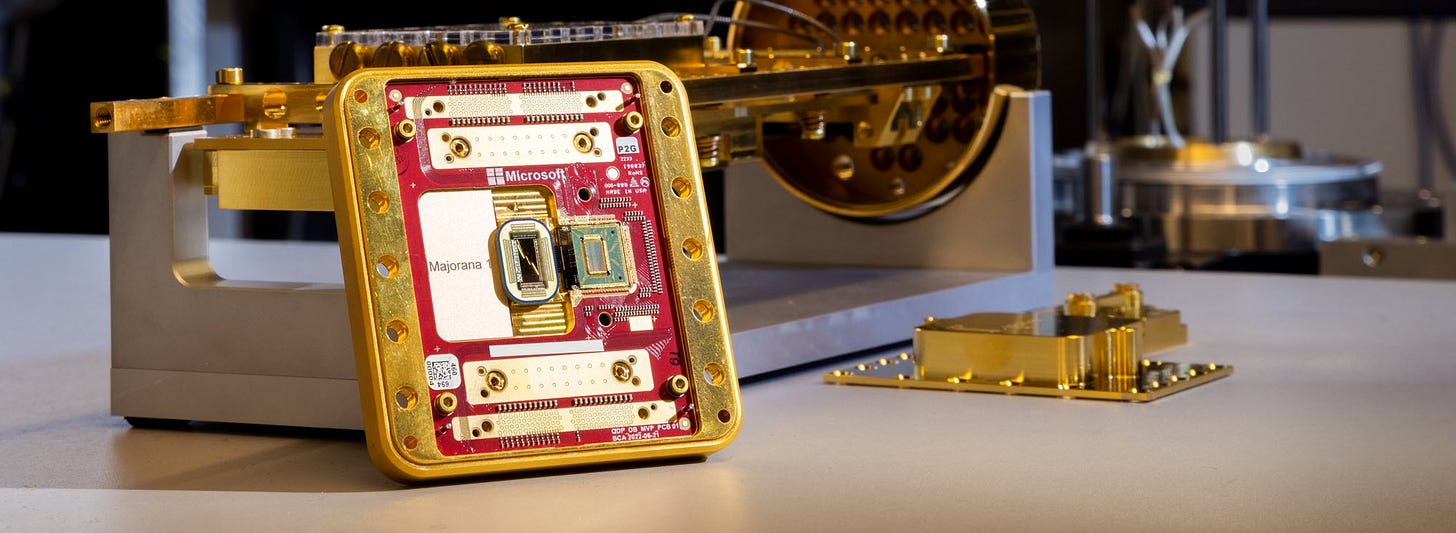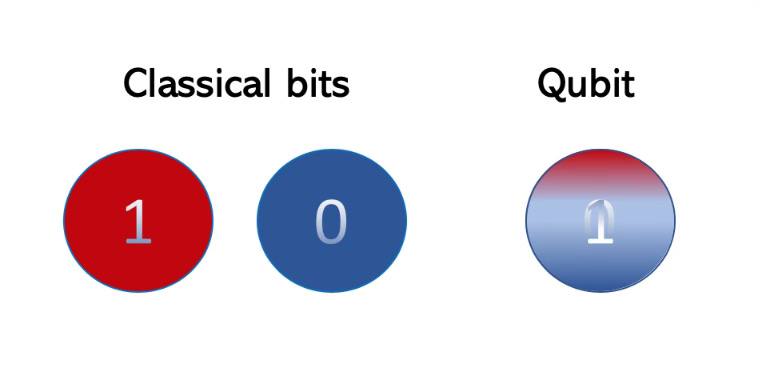Microsoft’s Quantum Breakthrough: A New State of Matter & Quantum Computing
Will Microsoft's Majorana 1 Chip Bring Large-Scale Quantum Computing?
This is The Curious Mind, by Álvaro Muñiz: a newsletter where you will learn about technical topics in an easy way, from decision-making to personal finance.
Microsoft just announced something straight out of science fiction: a new state of matter.
Besides the three states we know from school—liquid, gas and solid—there is now apparently a fourth one, called a topological state. This bizarre state of matter is present in topoconductors, a material that Microsoft has been working on for the past 20 years. Topoconductors make it possible to observe and control Majorana particles—exotic particles that don’t naturally exist but can be engineered using superconductors and magnetic fields.
Most importantly, Majorana particles hide quantum information, allowing more robust quantum computers. What are these, and what can they do?
Quantum vs Classical Computing
Everything a classical computer does, everything, is based on manipulating 0’s and 1’s.
Think of a computer as made up of many tiny switches that can be either on (1) or off (0). Each of these switches is called a bit, and by combining them in very complicated ways a computer can do all the amazing things that are now granted to us.
For example, when you type “Hello” into your keyboard, your screen shows the word “Hello” so that you can understand it, but what the computer is seeing is (literally) 01001000 01000101 01001100 01001100 01001111. When you type 2 + 7 and the computer returns 9, internally it is doing 010 + 111 = 1001.
In a quantum computer, everything is also based on 0’s and 1’s. To emphasise that things are now quantum, the basic units of classical computers, bits, are now called qubits. Now here is the key difference between a bit and a qubit:
Just like a switch can be on or off, a bit can be 1 or 0.
On the other hand, a qubit can be either 0, 1 or both at the same time.
This is called quantum superposition, and although it sounds like fiction, it is one of the main features of quantum mechanics. Quantum mechanics is the most precise theory we have in physics nowadays, and effects such as superposition are by now well-established at small scales.
The Problem of Quantum Computers
Your living room’s light bulb is never on and off at the same time, just as your cat cannot be alive and dead simultaneously. Where is this quantum superposition that is so relevant in quantum mechanics?
The problem with quantum superposition is that, although it exists, it is very fragile. If a qubit is in a superposition of 0 and 1, even a tiny change in room temperature can mess it up, throwing it into either 0 or 1 (but not both simultaneously anymore).
This is the reason why large-scale objects are not in a quantum superposition. You entering the room, the tiny molecule of dusk floating around or even the change in luminosity when a cloud arrives are all big enough disturbances to destroy quantum superposition.
This means quantum computer are very hard to build. On one side, you need to pretty much isolate the system, so that its qubits are not disturbed and can be in a quantum superposition. On the other hand, you also need a way to control and measures the qubits, so that you can tell it what to do and get its result after each task.
This is where Microsoft’s breakthrough comes in. Leveraging a new state of the matter present in topological superconductors, they created exotic particles called Majoranas.
Majorana particles help qubits stay in superposition, but they also make it hard to measure them. To solve this, Microsoft developed a measuring system using microwaves that is so precise that “it can detect the difference between one billion and one billion and one electrons in a superconducting wire”. This makes it possible to measure the states of qubits even with the Majorana hiding, forming the basis for quantum computation.
Microsoft claims that topoconductors might be to quantum computing what semiconductors were to modern electronics (smartphones, computers, transistors…).
The Potential of Quantum Computers
Quantum mechanics is the most precise physical theory that we have nowadays.
It describes nature with a precision that is hard to even think of. To give you an idea, quantum electrodynamics predicts a value for the so-called Sommerfeld constant that is accurate to within one part in a billion. This means it is accurate to within 0.000000001, a precision that is unthought of in other areas of physics.
Now imagine a quantum computer, built on the very principles that govern nature. It could simulate the world around us with unprecedented accuracy. For instance, here are some things that quantum computers could make possible (according to Microsoft’s article and IndieHacker’s post):
Design materials that repair themselves (like a bridge that fixes its own cracks).
Figure out how to break down harmful microplastics.
Help discover better catalysts (chemicals that speed up reactions) to clean up pollution.
The Present & The Future
Hype aside, we’re still a long way from large-scale quantum computing.
Microsoft’s current Majorana 1 chip has 8 qubits, while we would need millions of qubits to reach the breakthroughs mentioned above. However, Microsoft seems confident that their chip will scale:
This new architecture used to develop the Majorana 1 processor offers a clear path to fit a million qubits on a single chip that can fit in the palm of one’s hand, Microsoft said.
Furthermore, they seem to be confident that Majorana 1 will speed things up considerably, claiming that "Today’s announcement puts that horizon within years, not decades".
Now, what is clear is that, whether it is Microsoft’s Majorana 1 or other architecture, the power of such a quantum computer would be well-beyond imagination:
All the world’s current computers operating together can’t do what a one-million-qubit quantum computer will be able to do.
Quantum Computing & AI?
Now let’s remember that we are also in the middle of an AI revolution.
Imagine an AI powered by a quantum computer. Here are some words from Matthias Troyer, a researcher at Microsoft:
The power of quantum computing, combined with AI tools, would allow someone to describe what kind of new material or molecule they want to create in plain language and get an answer that works straightaway – no guesswork or years of trial and error.
“Any company that makes anything could just design it perfectly the first time out. It would just give you the answer,” Troyer said. “The quantum computer teaches the AI the language of nature so the AI can just tell you the recipe for what you want to make.”
The future of AI and quantum computing together? It sounds like magic—but it might just be science. What do you think?
In case you missed it
The Limits of Democracy: What Arrow’s Impossibility Theorem Reveals about Fair Elections
How You Can Make Better Choices (Spoiler: Self-Interest Fails)
The Dangerous Illusion of Good Judgement: How We Misjudge Probability and What to Do About It




Materials that repair themselves? Sounds like science fiction!! 😱 I had a very hard time choosing between exciting and scary... haha